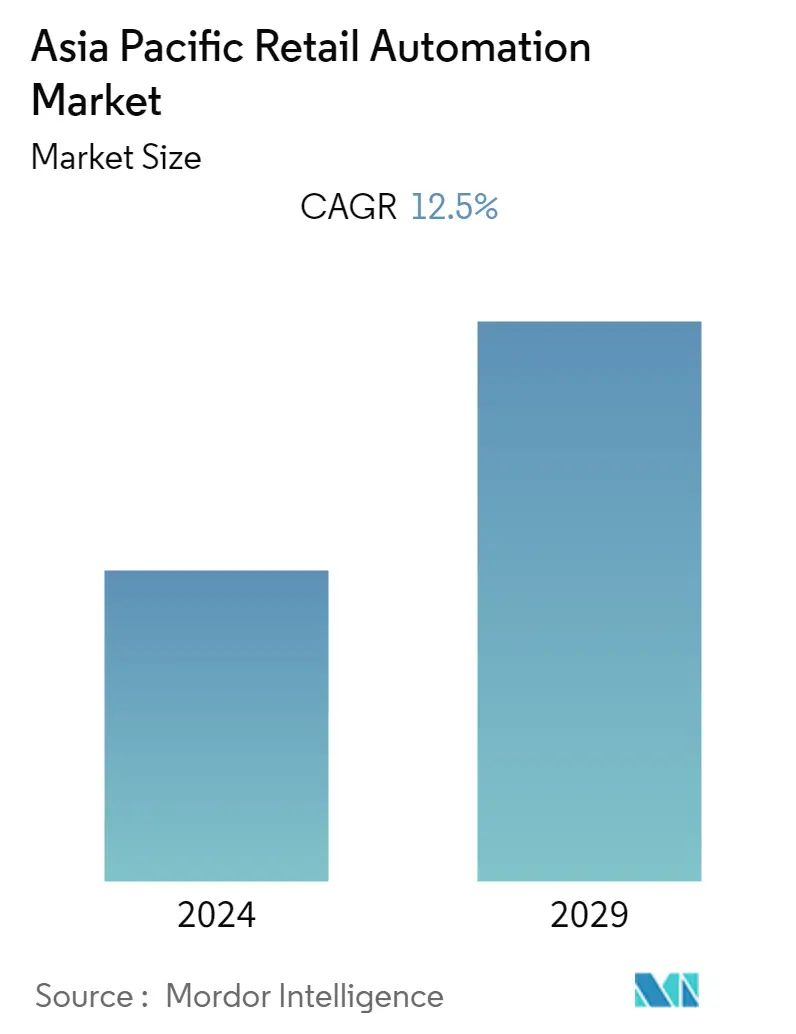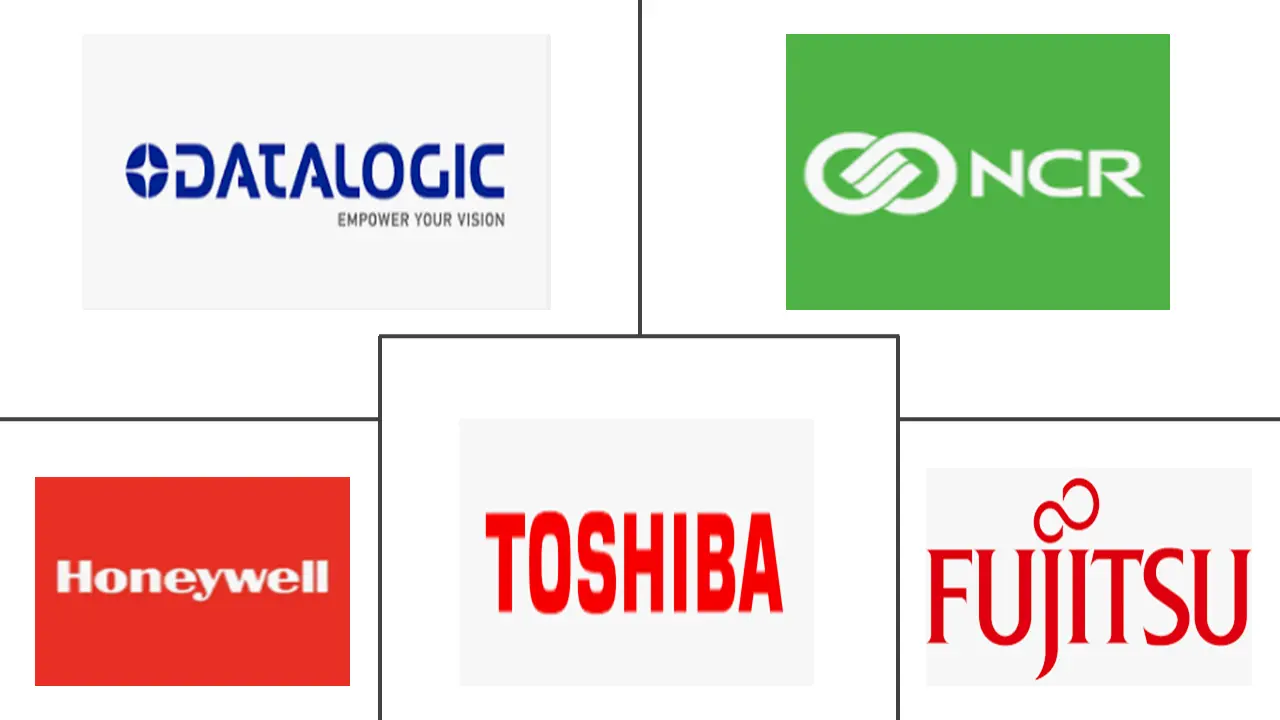Market Size of Asia Pacific Retail Automation Industry

| Study Period | 2019 - 2029 |
| Base Year For Estimation | 2023 |
| Forecast Data Period | 2024 - 2029 |
| Historical Data Period | 2019 - 2022 |
| CAGR | 12.50 % |
| Market Concentration | Medium |
Major Players
*Disclaimer: Major Players sorted in no particular order |
APAC Retail Automation Market Analysis
Asia Pacific Retail Automation Market is expected to grow at a CAGR of 12.5% during the forecast period 2020-2026. One of the primary factors driving the growth of the retail automation market is the increase in demand for advanced automated systems in retail across the Asia Pacific. Because of the several benefits it provides, such as precision, low cost, high-quality performance, and speed, it has accelerated market expansion. Accounting and bookkeeping, inventory management, purchasing, analytics reporting, and other repetitive operations are automated with advanced systems.
- In developing countries across the Asia Pacific, the number of physical stores is gradually expanding. The majority of people choose to buy daily-basis items from stores since they are convenient. As a result, despite the expansion of e-commerce, some visitors still prefer to shop in physical stores. The retail industry's increasing technologies will have an impact on bringing more people into physical locations. The advantages of automated technologies have prompted businesses to incorporate them into physical storefronts. As a result, the retail automation market for in-stores is expected to develop in the future years.
- Automation has become more common in the retail sector as a result of technological improvements. The advantages of automated retail have raised awareness of the benefits of automation in retail operations, such as purchase/sales services, inventory optimization, inventory optimization, and others, all of which are projected to fuel market growth. For instance, automated guided vehicles are used in warehouses to conduct heavy-lifting duties because they can operate continuously and complete repetitive tasks with the same efficiency and accuracy. As a result, the rise of autonomous guided vehicles (AGV) and other technologies in the retail business has encouraged automation adoption in the Asia Pacific.
- The food and non-food segment are considered an essential industry vertical in the retail automation market. This is due to tremendous improvement in the food and beverage business, increasing the number of restaurants, cafeterias, and franchisees. Non-food services, on the other hand, are progressing as many retail suppliers seek solutions for logistics, in-store support, product inspections, and promotional planning, which is positively impacting the retail automation market.
- COVID-19 pushed retailers to invest in automation technology (such as automated inventory management, robotic picking, analytics reporting, and so on) to improve operational efficiency and lower labor expenses. For instance, when compared to manually picking things off store shelves, the application of deep learning and robots provides significant time and cost savings. Now that the COVID-19 pandemic has sparked a surge in demand for online shopping, supermarket stores want to protect their employees while meeting customers' continuous desire for quick delivery.
APAC Retail Automation Industry Segmentation
The term "retail automation" refers to the use of computers and technology to create processes, systems, and workflows that operate independently and with little or no human intervention. Barcode readers, weighing scales, currency counters, bill printers, cash registers, card readers, kiosks, self-checkout systems, and other automation technology are part of an automated retail system. Automation has plowed its way into areas such as food/non-food, oil & gas, transportation & logistics, health & personal care, and hospitality due to the retail sector's adoption of technology.
| Product Type | |
| Point-of-Sale Systems Requiring Manual Intervention | |
| Unattended Terminals |
| Product | |
| Barcode reader | |
| Weighing scale | |
| Currency Counter | |
| Bill Printer | |
| Cash Register | |
| Card Reader | |
| Kiosks | |
| Self-Checkout Systems | |
| Others |
| End-user Application | |
| Food/Non-Food | |
| Oil and Gas | |
| Transportation and Logistics | |
| Health and Personal Care | |
| Hospitality | |
| Others |
| Country | |
| China | |
| India | |
| Japan | |
| South Korea | |
| Rest of Asia Pacific |
Asia Pacific Retail Automation Market Size Summary
The Asia Pacific retail automation market is experiencing significant growth, driven by the increasing demand for advanced automated systems in retail environments. These systems offer numerous benefits, including precision, cost-effectiveness, high-quality performance, and speed, which have contributed to the market's expansion. As physical stores continue to grow in developing countries within the region, the integration of automated technologies in these locations is expected to attract more customers, despite the rise of e-commerce. The adoption of automation in retail operations, such as inventory management and sales services, is further propelled by technological advancements, with automated guided vehicles and other innovations playing a crucial role in enhancing operational efficiency.
The market is characterized by a diverse range of products, including barcode readers, card readers, kiosks, and self-checkout systems, which are in high demand due to the need for quick distribution and competitive advantage in the retail sector. Prominent companies are investing in digital solutions to modernize operations, with a focus on frictionless shopping and automated inventory solutions. The use of handheld barcode readers/scanners is a key trend, offering cost-effective and versatile solutions for inventory management across various industries. The market is partially fragmented, with major players like Fujitsu Ltd., Toshiba Corporation, and Honeywell International Inc. making significant advancements to enhance customer experiences and streamline operations in the retail automation space.
Asia Pacific Retail Automation Market Size - Table of Contents
-
1. MARKET INSIGHTS
-
1.1 Market Overview
-
1.2 Value Chain / Supply Chain Analysis
-
1.3 Industry Attractiveness - Porter's Five Force Analysis
-
1.3.1 Threat of New Entrants
-
1.3.2 Bargaining Power of Buyers
-
1.3.3 Bargaining Power of Suppliers
-
1.3.4 Threat of Substitute Products
-
1.3.5 Intensity of Competitive Rivalry
-
-
1.4 Assessment of COVID-19 impact on the Industry
-
-
2. MARKET SEGMENTATION
-
2.1 Product Type
-
2.1.1 Point-of-Sale Systems Requiring Manual Intervention
-
2.1.2 Unattended Terminals
-
-
2.2 Product
-
2.2.1 Barcode reader
-
2.2.2 Weighing scale
-
2.2.3 Currency Counter
-
2.2.4 Bill Printer
-
2.2.5 Cash Register
-
2.2.6 Card Reader
-
2.2.7 Kiosks
-
2.2.8 Self-Checkout Systems
-
2.2.9 Others
-
-
2.3 End-user Application
-
2.3.1 Food/Non-Food
-
2.3.2 Oil and Gas
-
2.3.3 Transportation and Logistics
-
2.3.4 Health and Personal Care
-
2.3.5 Hospitality
-
2.3.6 Others
-
-
2.4 Country
-
2.4.1 China
-
2.4.2 India
-
2.4.3 Japan
-
2.4.4 South Korea
-
2.4.5 Rest of Asia Pacific
-
-
Asia Pacific Retail Automation Market Size FAQs
What is the current Asia Pacific Retail Automation Market size?
The Asia Pacific Retail Automation Market is projected to register a CAGR of 12.5% during the forecast period (2024-2029)
Who are the key players in Asia Pacific Retail Automation Market?
Datalogic S.P.A, Fujitsu Limited, Toshiba Corporation, NCR Corporation and Honeywell International Inc. are the major companies operating in the Asia Pacific Retail Automation Market.

